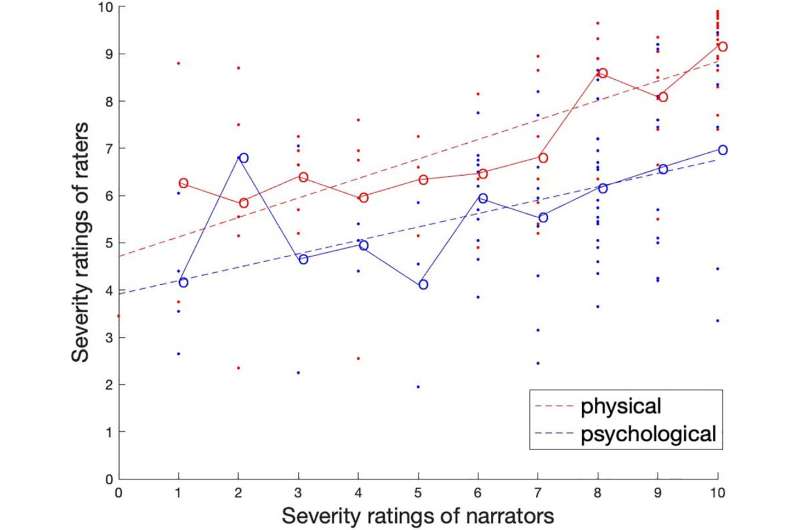The severity of violence as evaluated by the raters as a function of the evaluation of the narrators for all participants (men and women) in Phase 2. The data are divided into physical (red) and psychological (blue) violence. Each dot (N = 340) represents one narration. The straight dotted lines are fitted linear curves. The circles with solid lines represent averaged severity ratings. Credit: DOI: 10.1371/journal.pone.0255785
People have a hard time grasping the potential severity of psychological abuse and women's violence against men, according to a new study from Lund University in Sweden. The research reveals discrepancies in how victims—in contrast to the rest of society—evaluate different types of violence.
"Our study could have implications for how we assess violent crimes, for instance," says Sverker Sikström, lead author of the study and professor of psychology at Lund University.
Physical violence is often perceived as more severe than psychological violence. The same applies when a man is physically abused by a woman, as opposed to the other way round.
The research team asked 113 US participants to write a text describing either psychological or physical violence that they had experienced in an intimate relationship, and to rate how severe the violence was. These texts were then given to 340 other participants, that read them and also rated them for severity. The psychological abuse was rated as less severe by those reading about it, compared with those who had experienced it. In contrast, physical violence was rated as more severe by the readers.
"We often focus on how dangerous physical violence is and forget how much people suffer from psychological abuse," says Sverker Sikström. "This may simply be a communication issue, where we are unable to convey psychological suffering in the same way."
Isolation from others, verbal aggression, threats, control, harassment or insults are examples of psychological violence that are often experienced as worse than physical violence such as hitting, kicking, slapping, shaking, punching or choking.
The Lund researchers also examined the significance of gender for how physical violence is perceived. This was done by swapping the names of female and male perpetrators and victims. The violence was rated as worse if the rater incorrectly believed it was carried out by a man against a woman, than if it was the other way round.
The findings have implications for society, according to Sikström.
"We have laws against physical violence, whereas many types of psychological violence are legal, and lack any real consequence. We hope that our study can form the basis for a more accurate assessment of violent crimes, where communication difficulties and preconceived notions based on gender are taken into account," concludes Sverker Sikström.
More information: Sverker Sikström et al, What you say and what I hear—Investigating differences in the perception of the severity of psychological and physical violence in intimate partner relationships, PLOS ONE (2021). DOI: 10.1371/journal.pone.0255785
Journal information: PLoS ONE
Provided by Lund University




















